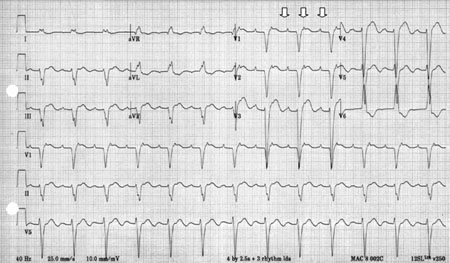Resumo
Definição
História e exame físico
Principais fatores diagnósticos
- presença de fatores de risco
- doença cardíaca
Outros fatores diagnósticos
- medicações
- palpitações
- fadiga, fraqueza
- dor torácica
- dispneia, tosse
- náuseas e vômitos
- tontura, síncope
- estertores
- edema
Fatores de risco
- uso indevido de substâncias (ingestão/abstinência de bebidas alcoólicas, cocaína, anfetaminas)
- toxicidade por digoxina
- cirurgia cardíaca prévia para corrigir os defeitos cardíacos congênitos
- doença arterial coronariana
- exacerbação da doença pulmonar crônica
- teofilina
Investigações diagnósticas
Primeiras investigações a serem solicitadas
- eletrocardiograma (ECG)
- nível de digoxina
- nível de teofilina
- radiografia torácica
- eletrólitos
- análise toxicológica
Investigações a serem consideradas
- manobras vagais, adenosina
- hormônios estimulantes da tireoide
- ecocardiograma
- ECG ambulatorial de 24 horas (Holter) ou registro de eventos
- estudo eletrofisiológico (EF)
Algoritmo de tratamento
adultos: taquicardia supraventricular indiferenciada
adultos: taquicardia atrial focal; não há suspeita de excesso de digoxina
adultos: taquicardia atrial focal; suspeita de toxicidade por digoxina
criança
adultos: taquicardia atrial focal sustentada ou recorrente
Colaboradores
Autores
Danesh Kella, MBBS, FHRS
Assistant Professor
Department of Cardiovascular Diseases
Division of Heart Rhythm
Mayo Clinic
Jacksonville
FL
Declarações
DK receives honoraria from Zoll Medical.
Agradecimentos
Dr Danesh Kella would like to gratefully acknowledge Dr Sarah Stahmer, previous contributor to this topic.
Revisores
Kathryn L. Berlacher, MD, MS
Assistant Professor and Cardiology Fellowship Program Director
University of Pittsburgh Medical Center
Pittsburgh
PA
Declarações
KLB declares that she has no competing interests.
Mehak Dhande, MD
Clinical Cardiac Electrophysiology Fellow
University of Pittsburgh Medical Center
Pittsburgh
PA
Declarações
MD declares that she has no competing interests.
Amal Mattu, MD
Associate Professor of Emergency Medicine
University of Maryland Medical Center
Baltimore
MD
Declarações
AM declares that he has no competing interests.
Vias Markides, MB(Hons), BS(Hons), MD, FRCP
Consultant Cardiologist
Royal Brompton & Harefield NHS Trust
Imperial College London
London
UK
Declarações
VM declares that he has no competing interests.
Créditos aos pareceristas
Os tópicos do BMJ Best Practice são constantemente atualizados, seguindo os desenvolvimentos das evidências e das diretrizes. Os pareceristas aqui listados revisaram o conteúdo pelo menos uma vez durante a história do tópico.
Declarações
As afiliações e declarações dos pareceristas referem--se ao momento da revisão.
Referências
Principais artigos
Page RL, Joglar JA, Caldwell MA, et al. 2015 ACC/AHA/HRS guideline for the management of adult patients with supraventricular tachycardia: a report of the American College of Cardiology/American Heart Association Task Force on Clinical Practice Guidelines and the Heart Rhythm Society. J Am Coll Cardiol. 2016 Apr 5;67(13):e27-e115.Texto completo Resumo
Brugada J, Katritsis DG, Arbelo E, et al. 2019 ESC guidelines for the management of patients with supraventricular tachycardia. The Task Force for the management of patients with supraventricular tachycardia of the European Society of Cardiology (ESC). Eur Heart J. 2020 Feb 1;41(5):655-720.Texto completo Resumo
Artigos de referência
Uma lista completa das fontes referenciadas neste tópico está disponível para os usuários com acesso total ao BMJ Best Practice.

Diagnósticos diferenciais
- Taquicardia sinusal
- Taquicardia por reentrada no nó atrioventricular
- Taquicardia por reentrada AV ou taquicardia mediada por via acessória
Mais Diagnósticos diferenciaisDiretrizes
- JCS/JHRS 2020 guideline on pharmacotherapy of cardiac arrhythmias
- 2019 ESC guidelines for the management of patients with supraventricular tachycardia
Mais DiretrizesConectar-se ou assinar para acessar todo o BMJ Best Practice
O uso deste conteúdo está sujeito ao nosso aviso legal